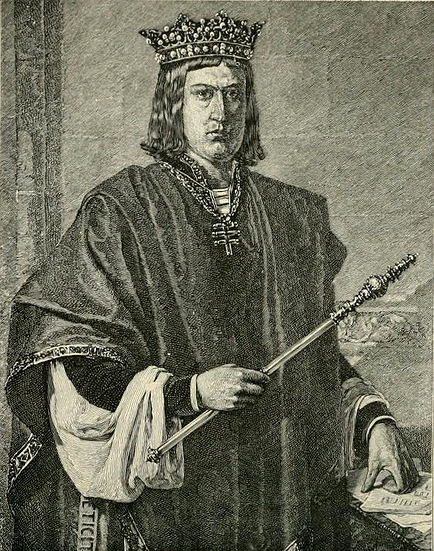“A King must outshine his subjects,” says Pulgar with a conviction born of his intimate knowledge of Spanish character…. [A]nd Ferdinand and Isabel, children of their race, were fully alive to the appeal of surroundings suitable to their rank.
Of the impression made by their magnificence on foreigners we can gather from the diary of a certain Roger Machado, who, in the capacity of king-at-arms, accompanied an English embassy to the Spanish Court at Medina del Campo in 1488….
The King is “dressed in a rich robe of cloth-of-gold, woven entirely of gold, and furred with a rich trimming of fine sable.” The Queen has “a rich robe of the same woven cloth-of-gold…and over the said robe a riding hood of black velvet, all slashed in large holes so as to show under the said velvet the cloth-of-gold in which she is dressed.” She wears “crosswise over her left side…a short cloak of fine crimson satin furred with ermine, very handsome in appearance and very brilliant.”
Roger Machado, had he lived today, would surely have made his fortune as journalist of some fashion-weekly; but his facile pen finds it difficult to express adequately the splendor of the Queen’s jewelry,—her necklace of gold and jeweled roses,—the ribbon at her breast adorned with diamonds, rubies, and pearls,—the pouch of her white leather girdle set “with a large balas ruby the size of a tennis ball between five rich diamonds and other stones the size of a bean.”
“Truly, as I believe,” he comments, “and also as I heard it said at the time, I estimate the dress she wore at the value of 200,000 crowns of gold”; while on another occasion he declares her dress so rich that “there is no man who can well imagine what could be the value of it.”
Ierne L. Plunket, Isabel of Castile and the Making of the Spanish Nation: 1451-1504 (New York: G. P. Putnam’s Sons, 1915), 321-23.
Short Stories on Honor, Chivalry, and the World of Nobility—no. 294












